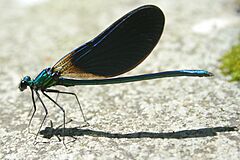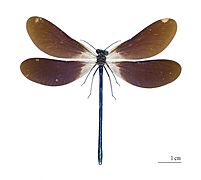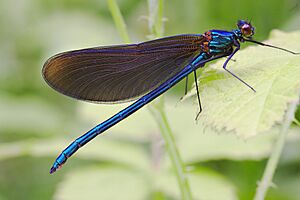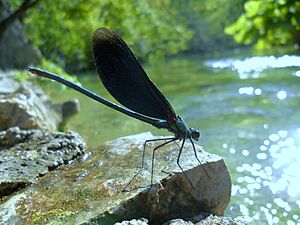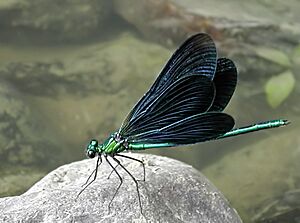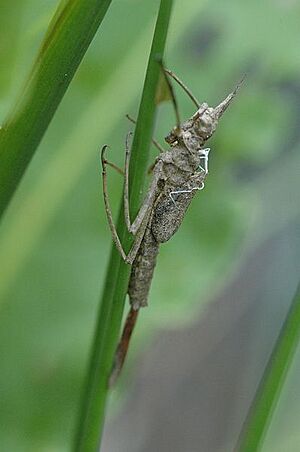Beautiful demoiselle facts for kids
Quick facts for kids Beautiful demoiselle |
|
|---|---|
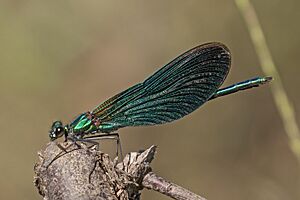 |
|
| Male | |
 |
|
| Female | |
| Conservation status | |
| Scientific classification | |
| Genus: |
Calopteryx (damselfly)
|
| Species: |
virgo
|
| Synonyms | |
|
List
Agrion colchicus von Eichwald, 1837
Agrion virgo (Linnaeus, 1758) Libellula virgo Linnaeus, 1758 Calopterix virgo (misspelling) |
|
The beautiful demoiselle (Calopteryx virgo) is a type of damselfly. It belongs to the family Calopterygidae. You can find these amazing insects in Europe, North Africa, and Western Asia. They often live near rivers and streams where the water flows quickly.
Contents
Different Kinds of Beautiful Demoiselles
There are five known groups, or subspecies, of the beautiful demoiselle:
- Calopteryx virgo britannica Conci, 1952
- Calopteryx virgo festiva (Brullé, 1832) (found in the eastern Mediterranean area)
- Calopteryx virgo meridionalis Sélys, 1853 (found in the western Mediterranean and southwest France)
- Calopteryx virgo padana Conci, 1956 (found in northern Italy)
- Calopteryx virgo virgo (Linnaeus, 1758)
What They Look Like
Eggs and Larvae
Female beautiful demoiselles can lay up to 300 eggs at once. They lay them on plants that float in the water, like water-crowfoot. Just like the banded demoiselle, they often go underwater to lay their eggs. The eggs hatch after about 14 days.
The baby damselflies, called larvae, look like sticks and have long legs. They grow for two years in plants underwater, in plant bits, or in roots. They usually spend the winter hidden in mud or slime.
Beautiful demoiselle larvae grow through 10 to 12 stages. Each stage ends with a moult, which means they shed their old skin. Their body length changes depending on where they live. In their last stage, they are about 3.5–4.6 millimeters long. You can tell them apart from other larvae by the tiny hairs on their gills on their belly.
These larvae are very slim and have long legs with strong claws. This helps them hold onto plants in fast-flowing water. They usually stay in calm spots, so they don't get swept away easily. If they do, they quickly grab onto plants or rocks.
Adult Damselflies
Adult beautiful demoiselles are about 49 to 54 millimeters long. Their back wings are about 31 to 37 millimeters long. These damselflies are large and dark. They have small eyes on the sides of their heads. Both pairs of their wings are similar in shape, and their bodies are thin. Their wings have many small veins.
Males and females look quite different. Males usually have very dark wings that are metallic blue-green. In some areas, like the Balkans and Turkey, their wings are completely metallic blue. In other places, their wings have clear spots at the base and tip. Young males have brown wings, and the blue color appears as they get older. Their bodies are also metallic blue-green, and their eyes are blue-green.
Females have dark brown, shiny wings. They have a white spot near the tip of their wings, called a pseudopterostigma. Their bodies are metallic green with a bronze tip on their abdomen.
This species looks a lot like the banded demoiselle (Calopteryx splendens), which is another damselfly with colored wings found in Britain.
Where They Live
Beautiful demoiselles live all over Europe. They are not found in the southwestern Iberian Peninsula, the Balearic Islands, or Iceland. They live much farther north than the banded demoiselle, even reaching the Arctic Ocean. In the south, you can find them as far as Morocco and Algeria.
They mostly live in low-lying areas. You can often find them up to 980 meters above sea level. Sometimes, they are seen even higher, up to 1,200 meters, like in the Alps.
Their Home
Preferred Environment
Beautiful demoiselles mostly live near small to medium-sized streams and creeks. They like water that is cool and flows at a moderate to fast speed. The water must not have too many nutrients (eutrophic means rich in nutrients). In northern places like Norway and Finland, they also live near larger rivers. These waters are usually close to forests.
Larval Habitat
The larvae live in streams and need water plants to survive. They hold onto the stems and leaves, especially where the current is strong. Because of this, you rarely find them in places without plants, or on flat, smooth stone floors. They can also live in small natural lakes or ponds with limestone at the bottom. They hide in calm spots among fallen leaves or exposed roots. You can find them on plants like waterweed (Elodea sp.) or water crowfoot (Ranunculus fluitans).
Compared to banded demoiselle larvae, beautiful demoiselle larvae prefer calmer water. Slower currents help them get more oxygen underwater. They almost never live in still water. They mostly stay hidden in plants.
Oxygen in the water is very important for beautiful demoiselle larvae. They are much more sensitive to low oxygen than banded demoiselle larvae. They need plenty of oxygen in the water. Waters with a lot of mud or dirt are not good homes for them.
Water temperature is another key factor. This species likes cooler, shady water. The best summer temperature for them is between 13 and 18 °C. If the temperature goes above 22 °C, larvae can get hurt, and fewer eggs will hatch.
Adult Habitat
Adult beautiful demoiselles live near where the larvae grow up. Unlike banded demoiselle adults, you might find beautiful demoiselles in forest clearings. They rarely go to the banks of large ponds. They use trees and bushes to rest. They often perch on tall plants like the large nettle (Urtica dioica).
Their breeding spots are similar to where the larvae live. They like cool, shady waterways with a good current. The banks should have natural plants. This is often in meadows and pastures, but rarely in deep forests. Plants along the riverbanks also help block the wind. Beautiful demoiselles have wide wings, so they can be blown away more easily by wind than other damselflies.
Behavior
Male beautiful demoiselles are territorial. This means they claim an area and defend it. They sit on plants and trees near the water, waiting for females or chasing other insects. They often return to the same spot. Females usually live away from the water unless they are laying eggs or looking for a mate.
Adult males show strong territorial behavior. They defend their areas from other males. They mostly do this by showing off, spreading their wings so they are clearly seen. The best territories are good places for females to lay eggs. These spots have good water flow and suitable places for eggs. The size of their territories depends on how many damselflies are around and how much good habitat is available. Males without a territory might stay in plants near the bank and try to take over an empty spot. If there are only a few males, they fight very hard to defend their territory. If there are many males, they are less aggressive.
Males defend their territories from high spots in the plants over the water, or sometimes on plants or rocks in the water. From here, they watch their territory and do a special move called "wing lapping." This is when they quickly flap their wings down and then slowly lift them up. Scientists think this is mostly for talking to other damselflies. It might also help them cool down their bodies.
Mating and Egg Laying
Beautiful demoiselles mate in a similar way to other Calopteryx damselflies. Females fly over the water looking for good places to lay eggs. As they fly, they pass through the males' territories. Males will fly towards the female, doing special aerial moves only seen during courtship. They also show the bright underside of their abdomen. The male then leads the female to a nesting spot. He circles the area once as the female lands. The male hovers, waiting for the female to land, which shows she is ready to mate. The pair then form a "mating wheel," and mating can last from 40 seconds to 5 minutes.
After mating, the male lets go of the female and shows her the nesting site. The eggs are laid in the stems of water plants, either at or below the water level. The female can stay underwater for up to 90 minutes while laying eggs. Unlike most other damselflies, the female climbs upside down onto the stem. She uses her ovipositor (a special egg-laying tool) to stab the eggs into the stem, placing them almost straight up. While the female lays eggs, the male waits above her, protecting her from other males. Both males and females mate many times a day for several weeks until they die.
Larval Life Cycle
The development of a damselfly has three main parts. First, the early growth after the egg is fertilized, where the basic body shape forms. Second, the continued growth of the body shape until they hatch from the egg. Finally, the larval growth of the hatched individuals until their wings are fully formed.
Beautiful demoiselle eggs are about 1.2 millimeters long and 0.2 millimeters wide. They are shaped like a spindle. At the pointed end of the egg, there are four tiny holes where the male's sperm enters. The eggs also have a small, funnel-like part that helps them stick out from the plant stem. Freshly laid eggs are bright yellow, but they turn yellow-brown as they get older.
Once the eggs are laid and fertilized, the baby damselfly starts to grow inside. This process was first described for the beautiful demoiselle in 1869. It was the first time anyone described how an insect embryo develops. You can see the embryo growing from the outside by small changes in the egg's shape. The top part of the egg bulges slightly, and the bottom part becomes curved inwards. Eggs usually hatch between 20 days and one month after being fertilized.
In the Middle East, beautiful demoiselle larvae usually take 6–8 weeks to develop. This is because they prefer cooler waters. This is a bit longer than the banded demoiselle. Larvae continue to grow over the winter. Some will change into adults the next year. If the water is cooler during breeding, more larvae will spend two winters growing, meaning they take almost two years to develop.
The larvae are predators. They mostly eat other insect larvae, such as black flies, midges, stoneflies, and mayflies. They might also eat small amphipods. Larvae will defend themselves against other damselfly larvae, especially those of their own kind.
Larvae are much more sensitive to changes in their home than banded demoiselles. This is especially true for temperature changes. Just a few days without enough oxygen can cause many larvae to die. Even after oxygen levels return to normal, there can still be more deaths and birth defects. This is because beautiful demoiselles are not very good at getting oxygen from water. They make up for this by choosing habitats where the water flows faster and is cooler, which helps them absorb more oxygen.
Hatching into Adults
Adult beautiful damselflies start to come out of the water at the end of April. They continue to emerge until the end of September, depending on the weather. Most of them hatch from late May to late June. They don't all hatch at the same time.
Newly hatched damselflies usually stay near where they hatched for about 10 days. They live in the plants around the water until their wings get their full color. After this, they go back to the water and start looking for mates. Adult damselflies only live for one season, usually about 40 to 50 days.
Males stay in sunny areas throughout the day. They usually arrive at the water early in the morning, between 7:00 A.M. and 9:00 A.M. in Central Europe. In shady places, they arrive later. They are often seen sunbathing on top of nearby plants. Females fly over the water all day, looking for good places to lay eggs. Both males and females hunt, show off, mate, and lay eggs during the warm middle of the day. At night, they return to the same sunny spots in the plants where they started their day.
Male beautiful damselflies do not travel far from their breeding, hunting, and resting areas. They only go about 20 to 100 meters. Females have been seen flying much farther, up to 4 kilometers (about 2.5 miles) in a day.
Helping Them Survive
The beautiful demoiselle is very particular about where it lives. Its larvae can only grow well in natural waters that humans haven't changed much. In most places where they live, this species is very rare. You won't find them in big cities or industrial areas. Even in farming regions, they are rare. Because of this, in some parts of Germany, they are listed as endangered, or even in danger of disappearing completely. The same is true in Austria, Switzerland, and other Central European countries. However, the IUCN (a global group that tracks species) says it is a species of least concern worldwide.
Several things can harm beautiful damselfly populations. They need certain water plants. When water gets too many nutrients from household or farm wastewater, it's called eutrophication. This causes too much algae to grow. The algae uses up oxygen in the water and changes the types of plants that grow there. Female damselflies might not accept the new plants for laying eggs. Also, the larvae have less to hold onto in the current, and algae and dirt can clog their gills, making it hard to breathe. Too much algae can also lead to more weeds and eventually fill up the water bodies with silt.
However, even clean, natural waters don't always guarantee a good home. Fast-growing plants, like meadowsweet (Filipendula ulmaria), stinging nettle (Urtica dioica), or Himalayan balsam (Impatiens glandulifera), can make the area too overgrown. Also, if trees grow too much along the water's edge, they can block the sunlight the damselflies need. To help, people can regularly remove some plants or thin out trees and bushes. In farming areas where manure is used, a bare strip of land a few meters wide can stop nutrients from reaching the water and causing eutrophication.
See also



